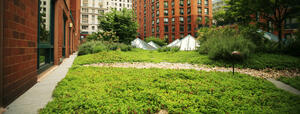The Benefits of a Green Roof Go Way Beyond Economics

May 28, 2019 — Mechanical equipment, roof systems, and Mother Earth all love a green roof.

One big thing. The Climate Mobilization Act, a New York City legislative package of seven bills that goes into gear in 2024. It’s the single largest carbon-reduction effort that any city has put forward, and it leaves you five, very short, years to get your building in shape.
Be smart. It’s estimated that there are a billion square feet of roof space in the city just waiting to be tapped for this climate initiative, and greening them is one measure the new legislation addresses. Installing a green roof costs more than a non-green one, but it provides economic benefits that a regular roof can’t. Here are some of the benefits:
If you have mechanical equipment on the roof, greening will boost its efficiency by making the air cooler. For an HVAC system, the cooler air will allow the equipment to operate at a lower ambient temperature and use less energy.
A green roof will reduce the temperature of the roof, and therefore, the building itself. It serves as insulation, which decreases the amount of heat passing into the building, reduces cooling loads, and even offers some insulation during heating season.
It can increase the life expectancy of a roofing system. A well-maintained green roof can more than double the number of years before a roof needs to be replaced compared to a standard roof, making up for some of the added costs of installation.
One level deeper. The city wants to encourage you to green the top of your building, so it has created (and in some cases updated) several programs which will help ease a green roof expense, including:
Property Tax Abatement. The city offers a one-time, one-year property tax abatement for a green roof. Currently it is $4.50 per square foot, but the new legislation (which has to be approved by the state and signed by Governor Andrew Cuomo) will provide a benefit of $15 per square foot. It is capped at whatever is less: $100,000 or the amount of property taxes due for the building that year. At least 50 percent of the roof space must be covered by the green roof, and if your building receives certain 421 benefits, it is not eligible. For condominiums, the abatement is divided among the individual units for one year.
PACE Financing. Property Assessed Clean Energy loans are a new municipally-sponsored program that provides funds for energy-saving projects. Instead of repaying a financial institution, a building pays off the loan through an assessment on its property taxes. The term is tied to the useful life of the improvement, up to 20 years. The theory is that the energy savings realized from the improvements will more than cover the repayment costs. Depending on several variables, green roofs are eligible for PACE financing, which is being administered by the nonprofit New York City Energy Efficiency Corp.
DEP Infrastructure Grant Program. Under this program, there is cash reimbursement for 100 percent of the design, materials, and construction costs of a green-roof system. While the grant covers basic green-roof elements (enough to manage the first inch of storm water), it does not cover more lavish green roofing elements such as paving stones, deeper soil systems, intensive plants, decking, and solar panels. To be eligible for the grant, a project’s minimum roof area to be greened is 3,500 square feet, and the depth of the soil is taken into account.
Bottom line. Dollar-wise it’s more expensive to install a green roof than a regular one. But if you add the incentives to the economic benefits, you win big – and so does our environment.

